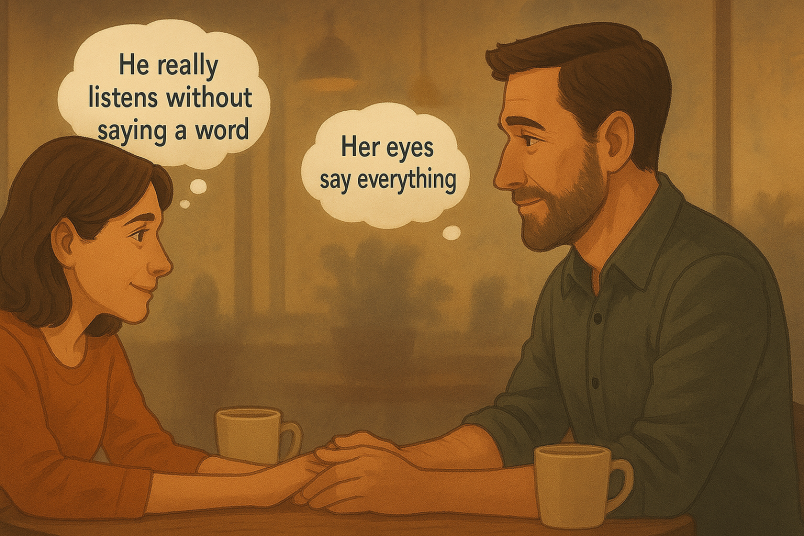Why Is Nonverbal Communication Important in Relationships?

Unlock Daily 30-Sec Tips for a Happier Relationship
👉 Subscribe FREEKey Takeaways
Marriage.com AI Quick Summary
Sometimes the things left unsaid speak the loudest! A tender smile, a lingering touch, or even the silence between words can reveal more than entire conversations.
In love, connection isn’t just about what’s spoken—it’s about the warmth in a glance, the reassurance of a hand held tightly, and the comfort of shared presence. Nonverbal communication in relationships often shapes trust, closeness, and understanding in ways words never could.
It’s the raised eyebrow that says “I get you,” the soft laugh that eases tension, and the simple gestures that weave two lives together… moment by moment, heart by heart.
What is nonverbal communication in a relationship?
Nonverbal communication in a relationship refers to the ways partners express feelings, thoughts, and intentions without words—through gestures, facial expressions, tone of voice, body language, touch, and even silence.
It often conveys emotions more powerfully than verbal communication and helps partners feel understood beyond spoken language.
A research paper published in 2016 states that much of human interaction—especially face-to-face—depends on nonverbal signals like facial expressions, gestures, posture and distance, often carrying more meaning than words.
Example: Imagine a couple where one partner feels anxious after a tough day. Without a word, the other gently places a hand on their shoulder and offers a warm smile. That simple act conveys support, care, and presence far more effectively than an elaborate explanation.
7 types of non-verbal communication
Nonverbal communication in relationships is more than just body language—it’s the whole set of signals we send without words.
From the way we look at someone to how we use space, each form carries meaning. Understanding the different types helps us connect better, build trust, and avoid misunderstandings, especially in close bonds.
1. Facial expressions
Facial expressions are the most powerful form of nonverbal communication because they instantly reveal emotions like joy, sadness, anger, or surprise. They often speak louder than words, even across cultures. When partners share smiles or empathetic looks, they create emotional closeness.
A research paper published in Frontiers in Psychology states that facial expressions are a powerful form of non-verbal communication, influencing how people judge, think, and behave toward others based on visible emotions.
A supportive expression can reassure someone more than spoken comfort. Recognizing these subtle cues helps us respond with greater care.
- Example: Smiling warmly when your partner shares good news.
2. Eye contact
Eye contact signals attention, honesty, and emotional presence. It shows whether someone is engaged in the conversation or distracted. In romantic settings, eye contact can deepen intimacy and foster trust.
A study published in 2017 states that making eye contact while listening activates brain areas involved in understanding others’ intentions, visual attention, and social connection more than looking at non‐eye regions.
Too little may feel like avoidance, while too much may seem overwhelming. Balanced eye contact strengthens connection and respect.
- Example: Holding eye contact during a heartfelt conversation.
3. Gestures
Gestures are deliberate movements like waving, pointing, or using hand signals to emphasize meaning. They add clarity to spoken words and sometimes replace them altogether.
However, gestures vary by culture, so context matters. In relationships, supportive gestures—like a thumbs-up—can encourage and uplift. Used thoughtfully, they make communication more expressive and relatable.
- Example: Nodding along to show agreement while your partner talks.
4. Posture and body movement
The way we sit, stand, or move reveals confidence, openness, or defensiveness. Leaning in signals interest, while crossing arms may show resistance or discomfort.
Posture communicates respect and emotional state in subtle but powerful ways. In nonverbal communication in close relationships, open body language creates a safe, inviting atmosphere.
- Example: Sitting side-by-side with relaxed shoulders during a talk.
5. Touch
Touch carries deep emotional meaning and is essential in close human bonds. It can comfort, heal, or express affection instantly. Holding hands, hugging, or a gentle pat communicates care without words. The absence of touch may signal distance or conflict. Used with sensitivity, touch builds trust and intimacy.
- Example: Giving your partner a reassuring hug after a stressful day.
6. Space (proxemics)
Personal space reflects comfort levels and the nature of relationships. Being physically close often shows trust and affection, while keeping distance may suggest formality or unease.
In nonverbal communication in interpersonal relationships, respecting boundaries is just as important as closeness. The right balance of space enhances comfort and respect.
- Example: Moving closer when your partner wants to share something emotional.
7. Tone of voice
It’s not just what we say but how we say it. Tone, pitch, speed, and volume shape the meaning of words. A gentle tone conveys care, while a harsh tone can escalate conflict.
In nonverbal communication in relationships, tone often determines how safe or loved someone feels. Voice is an emotional bridge.
- Example: Softening your tone when apologizing to your partner
Why is nonverbal communication necessary?
Nonverbal communication in relationships can be incredibly reassuring, and understanding the importance of nonverbal communication in relationships can be crucial for the longevity of your marriage/relationship.
It goes beyond words, helping couples build trust, show care, and sense each other’s feelings in subtle yet powerful ways.
1. Increases the closeness
From a warm smile to a slight touch on the arm are all forms of nonverbal communication in relationships that can help in increasing the closeness between you and your significant other. Such types of interaction play an essential role in how two people in a relationship can relate with one another.
2. Activates the unconscious mind
Most of the time, we fail to realize that the unconscious mind is powerful and plays a crucial role.
It picks up things that might not be that obvious; your unconscious mind is most likely to notice things about other people, what they’re doing, their reactions, etc. even though they might not be that obvious.
3. Understand feelings through body language
Body language is another example of nonverbal communication in marriage, a person’s posture can tell you a lot about what the other is thinking. There are individuals who can’t or don’t want to say what they feel. Determining nonverbal cues can help one understand what their spouse is going through.
4. Show care through simple gestures
While apologizing, smile a bit to show that you really are sorry. When you see your partner is stressed out, a hug or a light touch on their arm will show them that you’re there for them even if they don’t wish to talk about it yet
5. Detects dishonesty
Another interesting fact about nonverbal communication is that it becomes easier to catch a cheater or a liar. Their unwillingness to make eye contact during conversations, their body language, and hand movements will tell you they are hiding something or simply lying.
How to improve your nonverbal communication: 5 ways
Improving nonverbal communication in relationships starts with being more aware of the signals you send and receive. Small changes in body language, eye contact, touch, and tone can make your partner feel truly understood and valued.
1. Express your affection and love
Telling your partner you love them is a great way to keep your marriage happy and healthy. And to do that it’s not necessary to say the three words ‘I love you’ every single time. In fact, you can also express your love through other sweet and kind gestures.
- Example: Make use of simple gestures such as holding their hands or rubbing their shoulders while watching TV, or even giving them an expected hug.
2. Pay attention to each other’s moods
A healthy marriage requires you and your partner to pay attention to each other’s moods and emotions. People tend to give out quite a lot of cues regarding their mood nonverbally; you must understand these signals to know what’s going on in their minds.
- Example: if they’re making a lot of noise while washing the dishes, it might be their way to tell you they’re feeling upset about something.
3. Handle disagreements positively
No marriage is free from disagreements. However, you can prevent a disagreement from turning into a full blown out argument. Nonverbal communication plays an essential role in verbal communication.
So, when expressing yourself during a disagreement, it’s often the words you don’t say, but communicate nonverbally, that can blow the situation out of proportion.
- Example: Instead of rolling your eyes, turning your hands into fists, or banging your hand on something, it won’t help you. It’s better to maintain a positive posture during an argument.
Watch this TED Talk by Julie and John Gottman, relationship scientists who share how even healthy couples fight—and how the way they argue predicts trust, closeness, and future happiness.
4. Surprise them from time to time
There are a lot of ways you can communicate your feelings and affections without speaking a word. This is why nonverbal communication in relationships is important.
It might take time to perfect them, but with enough devotion, you’ll be able to strengthen your marital relationship with both verbal and nonverbal interaction.
- Example: You can surprise your partner by doing small things, such as leaving sweet notes for them to read, getting or making little gifts for them, buying flowers, cooking dinner or simply doing their share of the chores.
5. Match your partner’s energy
Sometimes the best way to show empathy is to mirror your partner’s mood and energy in a supportive way. This makes them feel understood without needing long explanations. Matching their tone or pace shows connection and emotional alignment.
- Example: Sitting quietly beside your partner when they’re tired instead of trying to force a lively chat.
FAQ
Relationships thrive on understanding, and sometimes the unspoken signals matter just as much as the words. Here are quick insights into questions people often have about nonverbal connection.
-
Why is nonverbal communication sometimes stronger than words?
Because emotions often show through tone, expressions, or body language before we even speak. These signals can reveal true feelings more powerfully than carefully chosen words.
-
Can cultural differences affect nonverbal communication?
Yes, gestures, eye contact, and even personal space vary across cultures. Being aware of these differences helps avoid misinterpretation and builds respect in diverse relationships.
-
How can I become more aware of my own nonverbal signals?
Practice self-awareness by noticing your posture, tone, and expressions during conversations. Reflecting on your body language helps you align your signals with your true intentions.
Silent strength
Nonverbal communication in relationships is the quiet language that shapes how couples connect, understand, and support one another. From gentle touches to eye contact and body language, these unspoken signals often carry more meaning than words.
Paying attention to them helps strengthen trust, reduce misunderstandings, and build deeper intimacy. Whether in daily routines or during conflicts, the way we listen with our eyes, respond with gestures, and show up with presence makes relationships truly lasting and meaningful.
 Tips
Tips
Write your tip or submit a video tip
All tips are reviewed before the publishing.
Share this article on
Want to have a happier, healthier marriage?
If you feel disconnected or frustrated about the state of your marriage but want to avoid separation and/or divorce, the marriage.com course meant for married couples is an excellent resource to help you overcome the most challenging aspects of being married.
Recent Articles
Related Quizzes
Unlock Daily 30-Sec Tips for a Happier, Healthier Relationship
👉 Subscribe FREE on YouTube We'd love your feedback!
We'd love your feedback!
 Expert Q&A
Expert Q&A
Ask your question related to this topic & get the support you deserve from experts.

 Reviewed By
Reviewed By


















 Thanks for your feedback!
Thanks for your feedback!